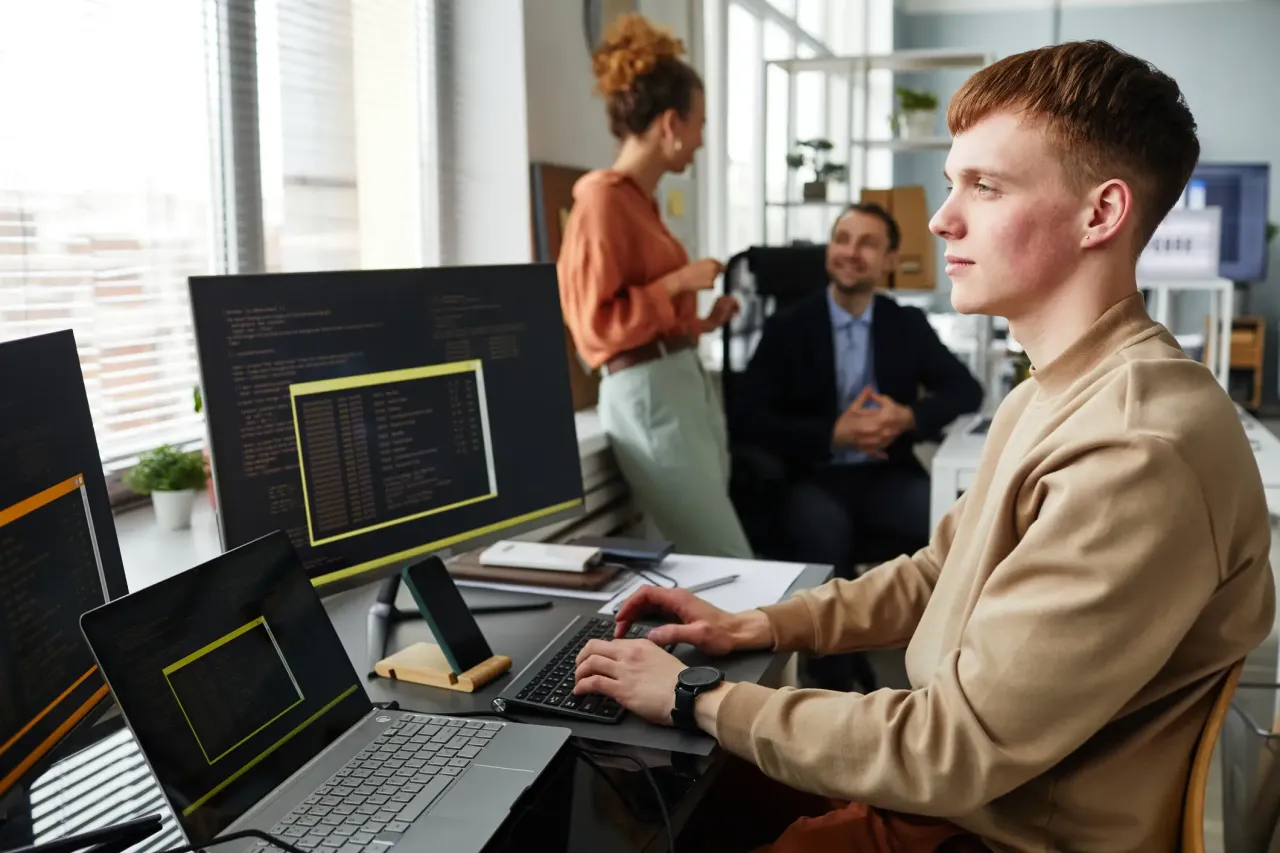Some of our partners
[{"redirect_url":"https:\/\/www.landmark.edu\/news\/landmark-college-partners-with-cai-neurodiverse-solutions","asset_thumbnail_url":"https:\/\/www.cai.io\/__data\/assets\/image\/0013\/12901\/landmark-logo.png","asset_data":{"assetid":"33156","type_code":"page_redirect","version":"0.1.0","name":"Landmark College","short_name":"Landmark College","external_id":false,"status":"16","languages":"en","charset":"utf-8","created":"2023-12-07 17:14:23","created_userid":"1619","updated":"2023-12-07 18:14:29","updated_userid":"1619","published":"2023-12-07 18:14:29","published_userid":"1619","status_changed":"2023-12-07 18:14:29","status_changed_userid":"1619","thumbnail":"12901","attributes":{"short_name":{"attrid":"2538","type":"text","value":"Landmark College","is_contextable":true,"use_default":true},"append_querystring":{"attrid":"2547","type":"boolean","value":false,"is_contextable":false,"use_default":true},"new_window_options":{"attrid":"2544","type":"selection","value":"","is_contextable":false,"use_default":true},"new_window_height":{"attrid":"2546","type":"int","value":"0","is_contextable":false,"use_default":true},"new_window_width":{"attrid":"2545","type":"int","value":"0","is_contextable":false,"use_default":true},"use_querystring_parameter":{"attrid":"2548","type":"text","value":"","is_contextable":false,"use_default":true},"new_window":{"attrid":"2543","type":"boolean","value":true,"is_contextable":false,"use_default":true},"timeout":{"attrid":"2542","type":"float","value":0,"is_contextable":false,"use_default":true},"session_variables":{"attrid":"2549","type":"parameter_map","value":[],"is_contextable":false,"use_default":true},"url_suffix":{"attrid":"2541","type":"text","value":"","is_contextable":false,"use_default":true},"redirect_url":{"attrid":"2540","type":"text","value":"https:\/\/www.landmark.edu\/news\/landmark-college-partners-with-cai-neurodiverse-solutions","is_contextable":false,"use_default":true},"permanent_redirect":{"attrid":"2539","type":"boolean","value":false,"is_contextable":false,"use_default":true},"session_vars":{"attrid":"2550","type":"option_list","value":"","is_contextable":false,"use_default":true},"name":{"attrid":"2537","type":"text","value":"Landmark College","is_contextable":true,"use_default":true}},"metadata":{"template":{"value":"article","fieldid":"754","type":"metadata_field_select","is_contextable":true,"default_value":true,"use_default":true},"publishedDate":{"value":"2025-01-01 00:00:00","fieldid":"10512","type":"metadata_field_date","is_contextable":true,"default_value":true,"use_default":true},"canonicalURL":{"value":"","fieldid":"36810","type":"metadata_field_related_asset","is_contextable":true,"default_value":true,"use_default":true},"voc_title":{"value":"","fieldid":"35766","type":"metadata_field_text","is_contextable":true,"default_value":true,"use_default":true},"summary":{"value":"","fieldid":"2208","type":"metadata_field_text","is_contextable":true,"default_value":true,"use_default":true},"heading_option":{"value":"no","fieldid":"4069","type":"metadata_field_select","is_contextable":true,"default_value":true,"use_default":true},"card_image":{"value":"","fieldid":"5919","type":"metadata_field_related_asset","is_contextable":true,"default_value":true,"use_default":true},"card_cta_text":{"value":"View this resource","fieldid":"16543","type":"metadata_field_text","is_contextable":true,"default_value":true,"use_default":true},"cLF_form_cta":{"value":"Get started","fieldid":"44035","type":"metadata_field_text","is_contextable":true,"default_value":true,"use_default":true},"display_parent_breadcrumb":{"value":"show","fieldid":"37776","type":"metadata_field_select","is_contextable":true,"default_value":true,"use_default":true},"footer_nav_link_styling":{"value":"","fieldid":"6936","type":"metadata_field_select","is_contextable":true,"default_value":true,"use_default":true},"robots":{"value":"all","fieldid":"33287","type":"metadata_field_select","is_contextable":true,"default_value":true,"use_default":true},"title":{"value":"Landmark College","fieldid":"33289","type":"metadata_field_text","is_contextable":true,"default_value":true,"use_default":true}}}},{"redirect_url":"https:\/\/disabilityin.org\/what-we-do\/committees\/neurodiversity-at-work-roundtable\/","asset_thumbnail_url":"https:\/\/www.cai.io\/__data\/assets\/image\/0025\/12895\/disabilityin-logo.png","asset_data":{"assetid":"33157","type_code":"page_redirect","version":"0.1.0","name":"DisabilityIn","short_name":"DisabilityIn","external_id":false,"status":"16","languages":"en","charset":"utf-8","created":"2023-12-07 17:16:37","created_userid":"1619","updated":"2023-12-07 18:14:29","updated_userid":"1619","published":"2023-12-07 18:14:29","published_userid":"1619","status_changed":"2023-12-07 18:14:29","status_changed_userid":"1619","thumbnail":"12895","attributes":{"short_name":{"attrid":"2538","type":"text","value":"DisabilityIn","is_contextable":true,"use_default":true},"append_querystring":{"attrid":"2547","type":"boolean","value":false,"is_contextable":false,"use_default":true},"new_window_options":{"attrid":"2544","type":"selection","value":"","is_contextable":false,"use_default":true},"new_window_height":{"attrid":"2546","type":"int","value":"0","is_contextable":false,"use_default":true},"new_window_width":{"attrid":"2545","type":"int","value":"0","is_contextable":false,"use_default":true},"use_querystring_parameter":{"attrid":"2548","type":"text","value":"","is_contextable":false,"use_default":true},"new_window":{"attrid":"2543","type":"boolean","value":true,"is_contextable":false,"use_default":true},"timeout":{"attrid":"2542","type":"float","value":0,"is_contextable":false,"use_default":true},"session_variables":{"attrid":"2549","type":"parameter_map","value":[],"is_contextable":false,"use_default":true},"url_suffix":{"attrid":"2541","type":"text","value":"","is_contextable":false,"use_default":true},"redirect_url":{"attrid":"2540","type":"text","value":"https:\/\/disabilityin.org\/what-we-do\/committees\/neurodiversity-at-work-roundtable\/","is_contextable":false,"use_default":true},"permanent_redirect":{"attrid":"2539","type":"boolean","value":false,"is_contextable":false,"use_default":true},"session_vars":{"attrid":"2550","type":"option_list","value":"","is_contextable":false,"use_default":true},"name":{"attrid":"2537","type":"text","value":"DisabilityIn","is_contextable":true,"use_default":true}},"metadata":{"template":{"value":"article","fieldid":"754","type":"metadata_field_select","is_contextable":true,"default_value":true,"use_default":true},"publishedDate":{"value":"2025-01-01 00:00:00","fieldid":"10512","type":"metadata_field_date","is_contextable":true,"default_value":true,"use_default":true},"canonicalURL":{"value":"","fieldid":"36810","type":"metadata_field_related_asset","is_contextable":true,"default_value":true,"use_default":true},"voc_title":{"value":"","fieldid":"35766","type":"metadata_field_text","is_contextable":true,"default_value":true,"use_default":true},"summary":{"value":"","fieldid":"2208","type":"metadata_field_text","is_contextable":true,"default_value":true,"use_default":true},"heading_option":{"value":"no","fieldid":"4069","type":"metadata_field_select","is_contextable":true,"default_value":true,"use_default":true},"card_image":{"value":"","fieldid":"5919","type":"metadata_field_related_asset","is_contextable":true,"default_value":true,"use_default":true},"card_cta_text":{"value":"View this resource","fieldid":"16543","type":"metadata_field_text","is_contextable":true,"default_value":true,"use_default":true},"cLF_form_cta":{"value":"Get started","fieldid":"44035","type":"metadata_field_text","is_contextable":true,"default_value":true,"use_default":true},"display_parent_breadcrumb":{"value":"show","fieldid":"37776","type":"metadata_field_select","is_contextable":true,"default_value":true,"use_default":true},"footer_nav_link_styling":{"value":"","fieldid":"6936","type":"metadata_field_select","is_contextable":true,"default_value":true,"use_default":true},"robots":{"value":"all","fieldid":"33287","type":"metadata_field_select","is_contextable":true,"default_value":true,"use_default":true},"title":{"value":"DisabilityIn","fieldid":"33289","type":"metadata_field_text","is_contextable":true,"default_value":true,"use_default":true}}}},{"redirect_url":"https:\/\/www.osu.edu\/","asset_thumbnail_url":"https:\/\/www.cai.io\/__data\/assets\/image\/0021\/12909\/ohio-state-logo.png","asset_data":{"assetid":"33158","type_code":"page_redirect","version":"0.1.0","name":"The Ohio State University","short_name":"The Ohio State University","external_id":false,"status":"16","languages":"en","charset":"utf-8","created":"2023-12-07 17:17:39","created_userid":"1619","updated":"2023-12-07 18:14:29","updated_userid":"1619","published":"2023-12-07 18:14:29","published_userid":"1619","status_changed":"2023-12-07 18:14:29","status_changed_userid":"1619","thumbnail":"12909","attributes":{"short_name":{"attrid":"2538","type":"text","value":"The Ohio State University","is_contextable":true,"use_default":true},"append_querystring":{"attrid":"2547","type":"boolean","value":false,"is_contextable":false,"use_default":true},"new_window_options":{"attrid":"2544","type":"selection","value":"","is_contextable":false,"use_default":true},"new_window_height":{"attrid":"2546","type":"int","value":"0","is_contextable":false,"use_default":true},"new_window_width":{"attrid":"2545","type":"int","value":"0","is_contextable":false,"use_default":true},"use_querystring_parameter":{"attrid":"2548","type":"text","value":"","is_contextable":false,"use_default":true},"new_window":{"attrid":"2543","type":"boolean","value":true,"is_contextable":false,"use_default":true},"timeout":{"attrid":"2542","type":"float","value":0,"is_contextable":false,"use_default":true},"session_variables":{"attrid":"2549","type":"parameter_map","value":[],"is_contextable":false,"use_default":true},"url_suffix":{"attrid":"2541","type":"text","value":"","is_contextable":false,"use_default":true},"redirect_url":{"attrid":"2540","type":"text","value":"https:\/\/www.osu.edu\/","is_contextable":false,"use_default":true},"permanent_redirect":{"attrid":"2539","type":"boolean","value":false,"is_contextable":false,"use_default":true},"session_vars":{"attrid":"2550","type":"option_list","value":"","is_contextable":false,"use_default":true},"name":{"attrid":"2537","type":"text","value":"The Ohio State University","is_contextable":true,"use_default":true}},"metadata":{"template":{"value":"article","fieldid":"754","type":"metadata_field_select","is_contextable":true,"default_value":true,"use_default":true},"publishedDate":{"value":"2025-01-01 00:00:00","fieldid":"10512","type":"metadata_field_date","is_contextable":true,"default_value":true,"use_default":true},"canonicalURL":{"value":"","fieldid":"36810","type":"metadata_field_related_asset","is_contextable":true,"default_value":true,"use_default":true},"voc_title":{"value":"","fieldid":"35766","type":"metadata_field_text","is_contextable":true,"default_value":true,"use_default":true},"summary":{"value":"","fieldid":"2208","type":"metadata_field_text","is_contextable":true,"default_value":true,"use_default":true},"heading_option":{"value":"no","fieldid":"4069","type":"metadata_field_select","is_contextable":true,"default_value":true,"use_default":true},"card_image":{"value":"","fieldid":"5919","type":"metadata_field_related_asset","is_contextable":true,"default_value":true,"use_default":true},"card_cta_text":{"value":"View this resource","fieldid":"16543","type":"metadata_field_text","is_contextable":true,"default_value":true,"use_default":true},"cLF_form_cta":{"value":"Get started","fieldid":"44035","type":"metadata_field_text","is_contextable":true,"default_value":true,"use_default":true},"display_parent_breadcrumb":{"value":"show","fieldid":"37776","type":"metadata_field_select","is_contextable":true,"default_value":true,"use_default":true},"footer_nav_link_styling":{"value":"","fieldid":"6936","type":"metadata_field_select","is_contextable":true,"default_value":true,"use_default":true},"robots":{"value":"all","fieldid":"33287","type":"metadata_field_select","is_contextable":true,"default_value":true,"use_default":true},"title":{"value":"The Ohio State University","fieldid":"33289","type":"metadata_field_text","is_contextable":true,"default_value":true,"use_default":true}}}},{"redirect_url":"https:\/\/ibcces.org\/","asset_thumbnail_url":"https:\/\/www.cai.io\/__data\/assets\/image\/0028\/12898\/ibcces-logo.png","asset_data":{"assetid":"33159","type_code":"page_redirect","version":"0.1.0","name":"IBCCES","short_name":"IBCCES","external_id":false,"status":"16","languages":"en","charset":"utf-8","created":"2023-12-07 17:18:33","created_userid":"1619","updated":"2023-12-07 18:14:29","updated_userid":"1619","published":"2023-12-07 18:14:29","published_userid":"1619","status_changed":"2023-12-07 18:14:29","status_changed_userid":"1619","thumbnail":"12898","attributes":{"short_name":{"attrid":"2538","type":"text","value":"IBCCES","is_contextable":true,"use_default":true},"append_querystring":{"attrid":"2547","type":"boolean","value":false,"is_contextable":false,"use_default":true},"new_window_options":{"attrid":"2544","type":"selection","value":"","is_contextable":false,"use_default":true},"new_window_height":{"attrid":"2546","type":"int","value":"0","is_contextable":false,"use_default":true},"new_window_width":{"attrid":"2545","type":"int","value":"0","is_contextable":false,"use_default":true},"use_querystring_parameter":{"attrid":"2548","type":"text","value":"","is_contextable":false,"use_default":true},"new_window":{"attrid":"2543","type":"boolean","value":true,"is_contextable":false,"use_default":true},"timeout":{"attrid":"2542","type":"float","value":0,"is_contextable":false,"use_default":true},"session_variables":{"attrid":"2549","type":"parameter_map","value":[],"is_contextable":false,"use_default":true},"url_suffix":{"attrid":"2541","type":"text","value":"","is_contextable":false,"use_default":true},"redirect_url":{"attrid":"2540","type":"text","value":"https:\/\/ibcces.org\/","is_contextable":false,"use_default":true},"permanent_redirect":{"attrid":"2539","type":"boolean","value":false,"is_contextable":false,"use_default":true},"session_vars":{"attrid":"2550","type":"option_list","value":"","is_contextable":false,"use_default":true},"name":{"attrid":"2537","type":"text","value":"IBCCES","is_contextable":true,"use_default":true}},"metadata":{"template":{"value":"article","fieldid":"754","type":"metadata_field_select","is_contextable":true,"default_value":true,"use_default":true},"publishedDate":{"value":"2025-01-01 00:00:00","fieldid":"10512","type":"metadata_field_date","is_contextable":true,"default_value":true,"use_default":true},"canonicalURL":{"value":"","fieldid":"36810","type":"metadata_field_related_asset","is_contextable":true,"default_value":true,"use_default":true},"voc_title":{"value":"","fieldid":"35766","type":"metadata_field_text","is_contextable":true,"default_value":true,"use_default":true},"summary":{"value":"","fieldid":"2208","type":"metadata_field_text","is_contextable":true,"default_value":true,"use_default":true},"heading_option":{"value":"no","fieldid":"4069","type":"metadata_field_select","is_contextable":true,"default_value":true,"use_default":true},"card_image":{"value":"","fieldid":"5919","type":"metadata_field_related_asset","is_contextable":true,"default_value":true,"use_default":true},"card_cta_text":{"value":"View this resource","fieldid":"16543","type":"metadata_field_text","is_contextable":true,"default_value":true,"use_default":true},"cLF_form_cta":{"value":"Get started","fieldid":"44035","type":"metadata_field_text","is_contextable":true,"default_value":true,"use_default":true},"display_parent_breadcrumb":{"value":"show","fieldid":"37776","type":"metadata_field_select","is_contextable":true,"default_value":true,"use_default":true},"footer_nav_link_styling":{"value":"","fieldid":"6936","type":"metadata_field_select","is_contextable":true,"default_value":true,"use_default":true},"robots":{"value":"all","fieldid":"33287","type":"metadata_field_select","is_contextable":true,"default_value":true,"use_default":true},"title":{"value":"IBCCES","fieldid":"33289","type":"metadata_field_text","is_contextable":true,"default_value":true,"use_default":true}}}},{"redirect_url":"https:\/\/danmarinofoundation.org\/","asset_thumbnail_url":"https:\/\/www.cai.io\/__data\/assets\/image\/0024\/12894\/dan-marino-foundation-logo.png","asset_data":{"assetid":"33160","type_code":"page_redirect","version":"0.1.0","name":"Dan Marino Foundation","short_name":"Dan Marino Foundation","external_id":false,"status":"16","languages":"en","charset":"utf-8","created":"2023-12-07 17:19:33","created_userid":"1619","updated":"2023-12-07 18:14:29","updated_userid":"1619","published":"2023-12-07 18:14:29","published_userid":"1619","status_changed":"2023-12-07 18:14:29","status_changed_userid":"1619","thumbnail":"12894","attributes":{"short_name":{"attrid":"2538","type":"text","value":"Dan Marino Foundation","is_contextable":true,"use_default":true},"append_querystring":{"attrid":"2547","type":"boolean","value":false,"is_contextable":false,"use_default":true},"new_window_options":{"attrid":"2544","type":"selection","value":"","is_contextable":false,"use_default":true},"new_window_height":{"attrid":"2546","type":"int","value":"0","is_contextable":false,"use_default":true},"new_window_width":{"attrid":"2545","type":"int","value":"0","is_contextable":false,"use_default":true},"use_querystring_parameter":{"attrid":"2548","type":"text","value":"","is_contextable":false,"use_default":true},"new_window":{"attrid":"2543","type":"boolean","value":true,"is_contextable":false,"use_default":true},"timeout":{"attrid":"2542","type":"float","value":0,"is_contextable":false,"use_default":true},"session_variables":{"attrid":"2549","type":"parameter_map","value":[],"is_contextable":false,"use_default":true},"url_suffix":{"attrid":"2541","type":"text","value":"","is_contextable":false,"use_default":true},"redirect_url":{"attrid":"2540","type":"text","value":"https:\/\/danmarinofoundation.org\/","is_contextable":false,"use_default":true},"permanent_redirect":{"attrid":"2539","type":"boolean","value":false,"is_contextable":false,"use_default":true},"session_vars":{"attrid":"2550","type":"option_list","value":"","is_contextable":false,"use_default":true},"name":{"attrid":"2537","type":"text","value":"Dan Marino Foundation","is_contextable":true,"use_default":true}},"metadata":{"template":{"value":"article","fieldid":"754","type":"metadata_field_select","is_contextable":true,"default_value":true,"use_default":true},"publishedDate":{"value":"2025-01-01 00:00:00","fieldid":"10512","type":"metadata_field_date","is_contextable":true,"default_value":true,"use_default":true},"canonicalURL":{"value":"","fieldid":"36810","type":"metadata_field_related_asset","is_contextable":true,"default_value":true,"use_default":true},"voc_title":{"value":"","fieldid":"35766","type":"metadata_field_text","is_contextable":true,"default_value":true,"use_default":true},"summary":{"value":"","fieldid":"2208","type":"metadata_field_text","is_contextable":true,"default_value":true,"use_default":true},"heading_option":{"value":"no","fieldid":"4069","type":"metadata_field_select","is_contextable":true,"default_value":true,"use_default":true},"card_image":{"value":"","fieldid":"5919","type":"metadata_field_related_asset","is_contextable":true,"default_value":true,"use_default":true},"card_cta_text":{"value":"View this resource","fieldid":"16543","type":"metadata_field_text","is_contextable":true,"default_value":true,"use_default":true},"cLF_form_cta":{"value":"Get started","fieldid":"44035","type":"metadata_field_text","is_contextable":true,"default_value":true,"use_default":true},"display_parent_breadcrumb":{"value":"show","fieldid":"37776","type":"metadata_field_select","is_contextable":true,"default_value":true,"use_default":true},"footer_nav_link_styling":{"value":"","fieldid":"6936","type":"metadata_field_select","is_contextable":true,"default_value":true,"use_default":true},"robots":{"value":"all","fieldid":"33287","type":"metadata_field_select","is_contextable":true,"default_value":true,"use_default":true},"title":{"value":"Dan Marino Foundation","fieldid":"33289","type":"metadata_field_text","is_contextable":true,"default_value":true,"use_default":true}}}},{"redirect_url":"https:\/\/melwood.org\/newsroom\/news\/the-event-will-bring-together-top-political-social-and-business-leaders-to-celebrate-national-disability-employment-awareness-month\/","asset_thumbnail_url":"https:\/\/www.cai.io\/__data\/assets\/image\/0016\/12904\/melwood-logo.png","asset_data":{"assetid":"33161","type_code":"page_redirect","version":"0.1.0","name":"Melwood","short_name":"Melwood","external_id":false,"status":"16","languages":"en","charset":"utf-8","created":"2023-12-07 17:20:26","created_userid":"1619","updated":"2023-12-07 18:14:29","updated_userid":"1619","published":"2023-12-07 18:14:29","published_userid":"1619","status_changed":"2023-12-07 18:14:29","status_changed_userid":"1619","thumbnail":"12904","attributes":{"short_name":{"attrid":"2538","type":"text","value":"Melwood","is_contextable":true,"use_default":true},"append_querystring":{"attrid":"2547","type":"boolean","value":false,"is_contextable":false,"use_default":true},"new_window_options":{"attrid":"2544","type":"selection","value":"","is_contextable":false,"use_default":true},"new_window_height":{"attrid":"2546","type":"int","value":"0","is_contextable":false,"use_default":true},"new_window_width":{"attrid":"2545","type":"int","value":"0","is_contextable":false,"use_default":true},"use_querystring_parameter":{"attrid":"2548","type":"text","value":"","is_contextable":false,"use_default":true},"new_window":{"attrid":"2543","type":"boolean","value":true,"is_contextable":false,"use_default":true},"timeout":{"attrid":"2542","type":"float","value":0,"is_contextable":false,"use_default":true},"session_variables":{"attrid":"2549","type":"parameter_map","value":[],"is_contextable":false,"use_default":true},"url_suffix":{"attrid":"2541","type":"text","value":"","is_contextable":false,"use_default":true},"redirect_url":{"attrid":"2540","type":"text","value":"https:\/\/melwood.org\/newsroom\/news\/the-event-will-bring-together-top-political-social-and-business-leaders-to-celebrate-national-disability-employment-awareness-month\/","is_contextable":false,"use_default":true},"permanent_redirect":{"attrid":"2539","type":"boolean","value":false,"is_contextable":false,"use_default":true},"session_vars":{"attrid":"2550","type":"option_list","value":"","is_contextable":false,"use_default":true},"name":{"attrid":"2537","type":"text","value":"Melwood","is_contextable":true,"use_default":true}},"metadata":{"template":{"value":"article","fieldid":"754","type":"metadata_field_select","is_contextable":true,"default_value":true,"use_default":true},"publishedDate":{"value":"2025-01-01 00:00:00","fieldid":"10512","type":"metadata_field_date","is_contextable":true,"default_value":true,"use_default":true},"canonicalURL":{"value":"","fieldid":"36810","type":"metadata_field_related_asset","is_contextable":true,"default_value":true,"use_default":true},"voc_title":{"value":"","fieldid":"35766","type":"metadata_field_text","is_contextable":true,"default_value":true,"use_default":true},"summary":{"value":"","fieldid":"2208","type":"metadata_field_text","is_contextable":true,"default_value":true,"use_default":true},"heading_option":{"value":"no","fieldid":"4069","type":"metadata_field_select","is_contextable":true,"default_value":true,"use_default":true},"card_image":{"value":"","fieldid":"5919","type":"metadata_field_related_asset","is_contextable":true,"default_value":true,"use_default":true},"card_cta_text":{"value":"View this resource","fieldid":"16543","type":"metadata_field_text","is_contextable":true,"default_value":true,"use_default":true},"cLF_form_cta":{"value":"Get started","fieldid":"44035","type":"metadata_field_text","is_contextable":true,"default_value":true,"use_default":true},"display_parent_breadcrumb":{"value":"show","fieldid":"37776","type":"metadata_field_select","is_contextable":true,"default_value":true,"use_default":true},"footer_nav_link_styling":{"value":"","fieldid":"6936","type":"metadata_field_select","is_contextable":true,"default_value":true,"use_default":true},"robots":{"value":"all","fieldid":"33287","type":"metadata_field_select","is_contextable":true,"default_value":true,"use_default":true},"title":{"value":"Melwood","fieldid":"33289","type":"metadata_field_text","is_contextable":true,"default_value":true,"use_default":true}}}},{"redirect_url":"https:\/\/www.pacareerlink.pa.gov\/jponline\/","asset_thumbnail_url":"https:\/\/www.cai.io\/__data\/assets\/image\/0013\/12910\/pa-careerlink-logo.png","asset_data":{"assetid":"33162","type_code":"page_redirect","version":"0.1.0","name":"Pennsylvania CareerLink","short_name":"Pennsylvania CareerLink","external_id":false,"status":"16","languages":"en","charset":"utf-8","created":"2023-12-07 17:21:23","created_userid":"1619","updated":"2023-12-07 18:14:30","updated_userid":"1619","published":"2023-12-07 18:14:30","published_userid":"1619","status_changed":"2023-12-07 18:14:30","status_changed_userid":"1619","thumbnail":"12910","attributes":{"short_name":{"attrid":"2538","type":"text","value":"Pennsylvania CareerLink","is_contextable":true,"use_default":true},"append_querystring":{"attrid":"2547","type":"boolean","value":false,"is_contextable":false,"use_default":true},"new_window_options":{"attrid":"2544","type":"selection","value":"","is_contextable":false,"use_default":true},"new_window_height":{"attrid":"2546","type":"int","value":"0","is_contextable":false,"use_default":true},"new_window_width":{"attrid":"2545","type":"int","value":"0","is_contextable":false,"use_default":true},"use_querystring_parameter":{"attrid":"2548","type":"text","value":"","is_contextable":false,"use_default":true},"new_window":{"attrid":"2543","type":"boolean","value":true,"is_contextable":false,"use_default":true},"timeout":{"attrid":"2542","type":"float","value":0,"is_contextable":false,"use_default":true},"session_variables":{"attrid":"2549","type":"parameter_map","value":[],"is_contextable":false,"use_default":true},"url_suffix":{"attrid":"2541","type":"text","value":"","is_contextable":false,"use_default":true},"redirect_url":{"attrid":"2540","type":"text","value":"https:\/\/www.pacareerlink.pa.gov\/jponline\/","is_contextable":false,"use_default":true},"permanent_redirect":{"attrid":"2539","type":"boolean","value":false,"is_contextable":false,"use_default":true},"session_vars":{"attrid":"2550","type":"option_list","value":"","is_contextable":false,"use_default":true},"name":{"attrid":"2537","type":"text","value":"Pennsylvania CareerLink","is_contextable":true,"use_default":true}},"metadata":{"template":{"value":"article","fieldid":"754","type":"metadata_field_select","is_contextable":true,"default_value":true,"use_default":true},"publishedDate":{"value":"2025-01-01 00:00:00","fieldid":"10512","type":"metadata_field_date","is_contextable":true,"default_value":true,"use_default":true},"canonicalURL":{"value":"","fieldid":"36810","type":"metadata_field_related_asset","is_contextable":true,"default_value":true,"use_default":true},"voc_title":{"value":"","fieldid":"35766","type":"metadata_field_text","is_contextable":true,"default_value":true,"use_default":true},"summary":{"value":"","fieldid":"2208","type":"metadata_field_text","is_contextable":true,"default_value":true,"use_default":true},"heading_option":{"value":"no","fieldid":"4069","type":"metadata_field_select","is_contextable":true,"default_value":true,"use_default":true},"card_image":{"value":"","fieldid":"5919","type":"metadata_field_related_asset","is_contextable":true,"default_value":true,"use_default":true},"card_cta_text":{"value":"View this resource","fieldid":"16543","type":"metadata_field_text","is_contextable":true,"default_value":true,"use_default":true},"cLF_form_cta":{"value":"Get started","fieldid":"44035","type":"metadata_field_text","is_contextable":true,"default_value":true,"use_default":true},"display_parent_breadcrumb":{"value":"show","fieldid":"37776","type":"metadata_field_select","is_contextable":true,"default_value":true,"use_default":true},"footer_nav_link_styling":{"value":"","fieldid":"6936","type":"metadata_field_select","is_contextable":true,"default_value":true,"use_default":true},"robots":{"value":"all","fieldid":"33287","type":"metadata_field_select","is_contextable":true,"default_value":true,"use_default":true},"title":{"value":"Pennsylvania CareerLink","fieldid":"33289","type":"metadata_field_text","is_contextable":true,"default_value":true,"use_default":true}}}},{"redirect_url":"https:\/\/www.inclusively.com\/","asset_thumbnail_url":"https:\/\/www.cai.io\/__data\/assets\/image\/0029\/12899\/inclusively-logo.png","asset_data":{"assetid":"33163","type_code":"page_redirect","version":"0.1.0","name":"Inclusively","short_name":"Inclusively","external_id":false,"status":"16","languages":"en","charset":"utf-8","created":"2023-12-07 17:22:20","created_userid":"1619","updated":"2023-12-07 18:14:30","updated_userid":"1619","published":"2023-12-07 18:14:30","published_userid":"1619","status_changed":"2023-12-07 18:14:30","status_changed_userid":"1619","thumbnail":"12899","attributes":{"short_name":{"attrid":"2538","type":"text","value":"Inclusively","is_contextable":true,"use_default":true},"append_querystring":{"attrid":"2547","type":"boolean","value":false,"is_contextable":false,"use_default":true},"new_window_options":{"attrid":"2544","type":"selection","value":"","is_contextable":false,"use_default":true},"new_window_height":{"attrid":"2546","type":"int","value":"0","is_contextable":false,"use_default":true},"new_window_width":{"attrid":"2545","type":"int","value":"0","is_contextable":false,"use_default":true},"use_querystring_parameter":{"attrid":"2548","type":"text","value":"","is_contextable":false,"use_default":true},"new_window":{"attrid":"2543","type":"boolean","value":true,"is_contextable":false,"use_default":true},"timeout":{"attrid":"2542","type":"float","value":0,"is_contextable":false,"use_default":true},"session_variables":{"attrid":"2549","type":"parameter_map","value":[],"is_contextable":false,"use_default":true},"url_suffix":{"attrid":"2541","type":"text","value":"","is_contextable":false,"use_default":true},"redirect_url":{"attrid":"2540","type":"text","value":"https:\/\/www.inclusively.com\/","is_contextable":false,"use_default":true},"permanent_redirect":{"attrid":"2539","type":"boolean","value":false,"is_contextable":false,"use_default":true},"session_vars":{"attrid":"2550","type":"option_list","value":"","is_contextable":false,"use_default":true},"name":{"attrid":"2537","type":"text","value":"Inclusively","is_contextable":true,"use_default":true}},"metadata":{"template":{"value":"article","fieldid":"754","type":"metadata_field_select","is_contextable":true,"default_value":true,"use_default":true},"publishedDate":{"value":"2025-01-01 00:00:00","fieldid":"10512","type":"metadata_field_date","is_contextable":true,"default_value":true,"use_default":true},"canonicalURL":{"value":"","fieldid":"36810","type":"metadata_field_related_asset","is_contextable":true,"default_value":true,"use_default":true},"voc_title":{"value":"","fieldid":"35766","type":"metadata_field_text","is_contextable":true,"default_value":true,"use_default":true},"summary":{"value":"","fieldid":"2208","type":"metadata_field_text","is_contextable":true,"default_value":true,"use_default":true},"heading_option":{"value":"no","fieldid":"4069","type":"metadata_field_select","is_contextable":true,"default_value":true,"use_default":true},"card_image":{"value":"","fieldid":"5919","type":"metadata_field_related_asset","is_contextable":true,"default_value":true,"use_default":true},"card_cta_text":{"value":"View this resource","fieldid":"16543","type":"metadata_field_text","is_contextable":true,"default_value":true,"use_default":true},"cLF_form_cta":{"value":"Get started","fieldid":"44035","type":"metadata_field_text","is_contextable":true,"default_value":true,"use_default":true},"display_parent_breadcrumb":{"value":"show","fieldid":"37776","type":"metadata_field_select","is_contextable":true,"default_value":true,"use_default":true},"footer_nav_link_styling":{"value":"","fieldid":"6936","type":"metadata_field_select","is_contextable":true,"default_value":true,"use_default":true},"robots":{"value":"all","fieldid":"33287","type":"metadata_field_select","is_contextable":true,"default_value":true,"use_default":true},"title":{"value":"Inclusively","fieldid":"33289","type":"metadata_field_text","is_contextable":true,"default_value":true,"use_default":true}}}},{"redirect_url":"https:\/\/www.easterseals.com\/de\/news-and-stories\/news\/eastersealscai-volleyball-7.html","asset_thumbnail_url":"https:\/\/www.cai.io\/__data\/assets\/image\/0027\/12897\/easterseals-logo.png","asset_data":{"assetid":"33164","type_code":"page_redirect","version":"0.1.0","name":"Easterseals","short_name":"Easterseals","external_id":false,"status":"16","languages":"en","charset":"utf-8","created":"2023-12-07 17:23:09","created_userid":"1619","updated":"2023-12-07 18:14:30","updated_userid":"1619","published":"2023-12-07 18:14:30","published_userid":"1619","status_changed":"2023-12-07 18:14:30","status_changed_userid":"1619","thumbnail":"12897","attributes":{"short_name":{"attrid":"2538","type":"text","value":"Easterseals","is_contextable":true,"use_default":true},"append_querystring":{"attrid":"2547","type":"boolean","value":false,"is_contextable":false,"use_default":true},"new_window_options":{"attrid":"2544","type":"selection","value":"","is_contextable":false,"use_default":true},"new_window_height":{"attrid":"2546","type":"int","value":"0","is_contextable":false,"use_default":true},"new_window_width":{"attrid":"2545","type":"int","value":"0","is_contextable":false,"use_default":true},"use_querystring_parameter":{"attrid":"2548","type":"text","value":"","is_contextable":false,"use_default":true},"new_window":{"attrid":"2543","type":"boolean","value":true,"is_contextable":false,"use_default":true},"timeout":{"attrid":"2542","type":"float","value":0,"is_contextable":false,"use_default":true},"session_variables":{"attrid":"2549","type":"parameter_map","value":[],"is_contextable":false,"use_default":true},"url_suffix":{"attrid":"2541","type":"text","value":"","is_contextable":false,"use_default":true},"redirect_url":{"attrid":"2540","type":"text","value":"https:\/\/www.easterseals.com\/de\/news-and-stories\/news\/eastersealscai-volleyball-7.html","is_contextable":false,"use_default":true},"permanent_redirect":{"attrid":"2539","type":"boolean","value":false,"is_contextable":false,"use_default":true},"session_vars":{"attrid":"2550","type":"option_list","value":"","is_contextable":false,"use_default":true},"name":{"attrid":"2537","type":"text","value":"Easterseals","is_contextable":true,"use_default":true}},"metadata":{"template":{"value":"article","fieldid":"754","type":"metadata_field_select","is_contextable":true,"default_value":true,"use_default":true},"publishedDate":{"value":"2025-01-01 00:00:00","fieldid":"10512","type":"metadata_field_date","is_contextable":true,"default_value":true,"use_default":true},"canonicalURL":{"value":"","fieldid":"36810","type":"metadata_field_related_asset","is_contextable":true,"default_value":true,"use_default":true},"voc_title":{"value":"","fieldid":"35766","type":"metadata_field_text","is_contextable":true,"default_value":true,"use_default":true},"summary":{"value":"","fieldid":"2208","type":"metadata_field_text","is_contextable":true,"default_value":true,"use_default":true},"heading_option":{"value":"no","fieldid":"4069","type":"metadata_field_select","is_contextable":true,"default_value":true,"use_default":true},"card_image":{"value":"","fieldid":"5919","type":"metadata_field_related_asset","is_contextable":true,"default_value":true,"use_default":true},"card_cta_text":{"value":"View this resource","fieldid":"16543","type":"metadata_field_text","is_contextable":true,"default_value":true,"use_default":true},"cLF_form_cta":{"value":"Get started","fieldid":"44035","type":"metadata_field_text","is_contextable":true,"default_value":true,"use_default":true},"display_parent_breadcrumb":{"value":"show","fieldid":"37776","type":"metadata_field_select","is_contextable":true,"default_value":true,"use_default":true},"footer_nav_link_styling":{"value":"","fieldid":"6936","type":"metadata_field_select","is_contextable":true,"default_value":true,"use_default":true},"robots":{"value":"all","fieldid":"33287","type":"metadata_field_select","is_contextable":true,"default_value":true,"use_default":true},"title":{"value":"Easterseals","fieldid":"33289","type":"metadata_field_text","is_contextable":true,"default_value":true,"use_default":true}}}},{"redirect_url":"https:\/\/www.kent.edu\/","asset_thumbnail_url":"https:\/\/www.cai.io\/__data\/assets\/image\/0012\/12900\/kent-state-logo.png","asset_data":{"assetid":"33165","type_code":"page_redirect","version":"0.1.0","name":"Kent State University","short_name":"Kent State University","external_id":false,"status":"16","languages":"en","charset":"utf-8","created":"2023-12-07 17:24:04","created_userid":"1619","updated":"2023-12-07 18:14:30","updated_userid":"1619","published":"2023-12-07 18:14:30","published_userid":"1619","status_changed":"2023-12-07 18:14:30","status_changed_userid":"1619","thumbnail":"12900","attributes":{"short_name":{"attrid":"2538","type":"text","value":"Kent State University","is_contextable":true,"use_default":true},"append_querystring":{"attrid":"2547","type":"boolean","value":false,"is_contextable":false,"use_default":true},"new_window_options":{"attrid":"2544","type":"selection","value":"","is_contextable":false,"use_default":true},"new_window_height":{"attrid":"2546","type":"int","value":"0","is_contextable":false,"use_default":true},"new_window_width":{"attrid":"2545","type":"int","value":"0","is_contextable":false,"use_default":true},"use_querystring_parameter":{"attrid":"2548","type":"text","value":"","is_contextable":false,"use_default":true},"new_window":{"attrid":"2543","type":"boolean","value":true,"is_contextable":false,"use_default":true},"timeout":{"attrid":"2542","type":"float","value":0,"is_contextable":false,"use_default":true},"session_variables":{"attrid":"2549","type":"parameter_map","value":[],"is_contextable":false,"use_default":true},"url_suffix":{"attrid":"2541","type":"text","value":"","is_contextable":false,"use_default":true},"redirect_url":{"attrid":"2540","type":"text","value":"https:\/\/www.kent.edu\/","is_contextable":false,"use_default":true},"permanent_redirect":{"attrid":"2539","type":"boolean","value":false,"is_contextable":false,"use_default":true},"session_vars":{"attrid":"2550","type":"option_list","value":"","is_contextable":false,"use_default":true},"name":{"attrid":"2537","type":"text","value":"Kent State University","is_contextable":true,"use_default":true}},"metadata":{"template":{"value":"article","fieldid":"754","type":"metadata_field_select","is_contextable":true,"default_value":true,"use_default":true},"publishedDate":{"value":"2025-01-01 00:00:00","fieldid":"10512","type":"metadata_field_date","is_contextable":true,"default_value":true,"use_default":true},"canonicalURL":{"value":"","fieldid":"36810","type":"metadata_field_related_asset","is_contextable":true,"default_value":true,"use_default":true},"voc_title":{"value":"","fieldid":"35766","type":"metadata_field_text","is_contextable":true,"default_value":true,"use_default":true},"summary":{"value":"","fieldid":"2208","type":"metadata_field_text","is_contextable":true,"default_value":true,"use_default":true},"heading_option":{"value":"no","fieldid":"4069","type":"metadata_field_select","is_contextable":true,"default_value":true,"use_default":true},"card_image":{"value":"","fieldid":"5919","type":"metadata_field_related_asset","is_contextable":true,"default_value":true,"use_default":true},"card_cta_text":{"value":"View this resource","fieldid":"16543","type":"metadata_field_text","is_contextable":true,"default_value":true,"use_default":true},"cLF_form_cta":{"value":"Get started","fieldid":"44035","type":"metadata_field_text","is_contextable":true,"default_value":true,"use_default":true},"display_parent_breadcrumb":{"value":"show","fieldid":"37776","type":"metadata_field_select","is_contextable":true,"default_value":true,"use_default":true},"footer_nav_link_styling":{"value":"","fieldid":"6936","type":"metadata_field_select","is_contextable":true,"default_value":true,"use_default":true},"robots":{"value":"all","fieldid":"33287","type":"metadata_field_select","is_contextable":true,"default_value":true,"use_default":true},"title":{"value":"Kent State University","fieldid":"33289","type":"metadata_field_text","is_contextable":true,"default_value":true,"use_default":true}}}},{"redirect_url":"https:\/\/www.mercyhurst.edu\/","asset_thumbnail_url":"https:\/\/www.cai.io\/__data\/assets\/image\/0018\/12906\/mercy-logo.png","asset_data":{"assetid":"33166","type_code":"page_redirect","version":"0.1.0","name":"Mercyhurst University","short_name":"Mercyhurst University","external_id":false,"status":"16","languages":"en","charset":"utf-8","created":"2023-12-07 17:24:57","created_userid":"1619","updated":"2023-12-07 18:14:30","updated_userid":"1619","published":"2023-12-07 18:14:30","published_userid":"1619","status_changed":"2023-12-07 18:14:30","status_changed_userid":"1619","thumbnail":"12906","attributes":{"short_name":{"attrid":"2538","type":"text","value":"Mercyhurst University","is_contextable":true,"use_default":true},"append_querystring":{"attrid":"2547","type":"boolean","value":false,"is_contextable":false,"use_default":true},"new_window_options":{"attrid":"2544","type":"selection","value":"","is_contextable":false,"use_default":true},"new_window_height":{"attrid":"2546","type":"int","value":"0","is_contextable":false,"use_default":true},"new_window_width":{"attrid":"2545","type":"int","value":"0","is_contextable":false,"use_default":true},"use_querystring_parameter":{"attrid":"2548","type":"text","value":"","is_contextable":false,"use_default":true},"new_window":{"attrid":"2543","type":"boolean","value":true,"is_contextable":false,"use_default":true},"timeout":{"attrid":"2542","type":"float","value":0,"is_contextable":false,"use_default":true},"session_variables":{"attrid":"2549","type":"parameter_map","value":[],"is_contextable":false,"use_default":true},"url_suffix":{"attrid":"2541","type":"text","value":"","is_contextable":false,"use_default":true},"redirect_url":{"attrid":"2540","type":"text","value":"https:\/\/www.mercyhurst.edu\/","is_contextable":false,"use_default":true},"permanent_redirect":{"attrid":"2539","type":"boolean","value":false,"is_contextable":false,"use_default":true},"session_vars":{"attrid":"2550","type":"option_list","value":"","is_contextable":false,"use_default":true},"name":{"attrid":"2537","type":"text","value":"Mercyhurst University","is_contextable":true,"use_default":true}},"metadata":{"template":{"value":"article","fieldid":"754","type":"metadata_field_select","is_contextable":true,"default_value":true,"use_default":true},"publishedDate":{"value":"2025-01-01 00:00:00","fieldid":"10512","type":"metadata_field_date","is_contextable":true,"default_value":true,"use_default":true},"canonicalURL":{"value":"","fieldid":"36810","type":"metadata_field_related_asset","is_contextable":true,"default_value":true,"use_default":true},"voc_title":{"value":"","fieldid":"35766","type":"metadata_field_text","is_contextable":true,"default_value":true,"use_default":true},"summary":{"value":"","fieldid":"2208","type":"metadata_field_text","is_contextable":true,"default_value":true,"use_default":true},"heading_option":{"value":"no","fieldid":"4069","type":"metadata_field_select","is_contextable":true,"default_value":true,"use_default":true},"card_image":{"value":"","fieldid":"5919","type":"metadata_field_related_asset","is_contextable":true,"default_value":true,"use_default":true},"card_cta_text":{"value":"View this resource","fieldid":"16543","type":"metadata_field_text","is_contextable":true,"default_value":true,"use_default":true},"cLF_form_cta":{"value":"Get started","fieldid":"44035","type":"metadata_field_text","is_contextable":true,"default_value":true,"use_default":true},"display_parent_breadcrumb":{"value":"show","fieldid":"37776","type":"metadata_field_select","is_contextable":true,"default_value":true,"use_default":true},"footer_nav_link_styling":{"value":"","fieldid":"6936","type":"metadata_field_select","is_contextable":true,"default_value":true,"use_default":true},"robots":{"value":"all","fieldid":"33287","type":"metadata_field_select","is_contextable":true,"default_value":true,"use_default":true},"title":{"value":"Mercyhurst University","fieldid":"33289","type":"metadata_field_text","is_contextable":true,"default_value":true,"use_default":true}}}},{"redirect_url":"https:\/\/nupaths.org\/","asset_thumbnail_url":"https:\/\/www.cai.io\/__data\/assets\/image\/0020\/12908\/nupaths-logo.png","asset_data":{"assetid":"33167","type_code":"page_redirect","version":"0.1.0","name":"NuPaths","short_name":"NuPaths","external_id":false,"status":"16","languages":"en","charset":"utf-8","created":"2023-12-07 17:26:34","created_userid":"1619","updated":"2023-12-07 18:14:30","updated_userid":"1619","published":"2023-12-07 18:14:30","published_userid":"1619","status_changed":"2023-12-07 18:14:30","status_changed_userid":"1619","thumbnail":"12908","attributes":{"short_name":{"attrid":"2538","type":"text","value":"NuPaths","is_contextable":true,"use_default":true},"append_querystring":{"attrid":"2547","type":"boolean","value":false,"is_contextable":false,"use_default":true},"new_window_options":{"attrid":"2544","type":"selection","value":"","is_contextable":false,"use_default":true},"new_window_height":{"attrid":"2546","type":"int","value":"0","is_contextable":false,"use_default":true},"new_window_width":{"attrid":"2545","type":"int","value":"0","is_contextable":false,"use_default":true},"use_querystring_parameter":{"attrid":"2548","type":"text","value":"","is_contextable":false,"use_default":true},"new_window":{"attrid":"2543","type":"boolean","value":true,"is_contextable":false,"use_default":true},"timeout":{"attrid":"2542","type":"float","value":0,"is_contextable":false,"use_default":true},"session_variables":{"attrid":"2549","type":"parameter_map","value":[],"is_contextable":false,"use_default":true},"url_suffix":{"attrid":"2541","type":"text","value":"","is_contextable":false,"use_default":true},"redirect_url":{"attrid":"2540","type":"text","value":"https:\/\/nupaths.org\/","is_contextable":false,"use_default":true},"permanent_redirect":{"attrid":"2539","type":"boolean","value":false,"is_contextable":false,"use_default":true},"session_vars":{"attrid":"2550","type":"option_list","value":"","is_contextable":false,"use_default":true},"name":{"attrid":"2537","type":"text","value":"NuPaths","is_contextable":true,"use_default":true}},"metadata":{"template":{"value":"article","fieldid":"754","type":"metadata_field_select","is_contextable":true,"default_value":true,"use_default":true},"publishedDate":{"value":"2025-01-01 00:00:00","fieldid":"10512","type":"metadata_field_date","is_contextable":true,"default_value":true,"use_default":true},"canonicalURL":{"value":"","fieldid":"36810","type":"metadata_field_related_asset","is_contextable":true,"default_value":true,"use_default":true},"voc_title":{"value":"","fieldid":"35766","type":"metadata_field_text","is_contextable":true,"default_value":true,"use_default":true},"summary":{"value":"","fieldid":"2208","type":"metadata_field_text","is_contextable":true,"default_value":true,"use_default":true},"heading_option":{"value":"no","fieldid":"4069","type":"metadata_field_select","is_contextable":true,"default_value":true,"use_default":true},"card_image":{"value":"","fieldid":"5919","type":"metadata_field_related_asset","is_contextable":true,"default_value":true,"use_default":true},"card_cta_text":{"value":"View this resource","fieldid":"16543","type":"metadata_field_text","is_contextable":true,"default_value":true,"use_default":true},"cLF_form_cta":{"value":"Get started","fieldid":"44035","type":"metadata_field_text","is_contextable":true,"default_value":true,"use_default":true},"display_parent_breadcrumb":{"value":"show","fieldid":"37776","type":"metadata_field_select","is_contextable":true,"default_value":true,"use_default":true},"footer_nav_link_styling":{"value":"","fieldid":"6936","type":"metadata_field_select","is_contextable":true,"default_value":true,"use_default":true},"robots":{"value":"all","fieldid":"33287","type":"metadata_field_select","is_contextable":true,"default_value":true,"use_default":true},"title":{"value":"NuPaths","fieldid":"33289","type":"metadata_field_text","is_contextable":true,"default_value":true,"use_default":true}}}},{"redirect_url":"https:\/\/www.marquette.edu\/","asset_thumbnail_url":"https:\/\/www.cai.io\/__data\/assets\/image\/0014\/12902\/marquette-logo.png","asset_data":{"assetid":"33168","type_code":"page_redirect","version":"0.1.0","name":"Marquette University","short_name":"Marquette University","external_id":false,"status":"16","languages":"en","charset":"utf-8","created":"2023-12-07 17:27:26","created_userid":"1619","updated":"2023-12-07 18:14:30","updated_userid":"1619","published":"2023-12-07 18:14:30","published_userid":"1619","status_changed":"2023-12-07 18:14:30","status_changed_userid":"1619","thumbnail":"12902","attributes":{"short_name":{"attrid":"2538","type":"text","value":"Marquette University","is_contextable":true,"use_default":true},"append_querystring":{"attrid":"2547","type":"boolean","value":false,"is_contextable":false,"use_default":true},"new_window_options":{"attrid":"2544","type":"selection","value":"","is_contextable":false,"use_default":true},"new_window_height":{"attrid":"2546","type":"int","value":"0","is_contextable":false,"use_default":true},"new_window_width":{"attrid":"2545","type":"int","value":"0","is_contextable":false,"use_default":true},"use_querystring_parameter":{"attrid":"2548","type":"text","value":"","is_contextable":false,"use_default":true},"new_window":{"attrid":"2543","type":"boolean","value":true,"is_contextable":false,"use_default":true},"timeout":{"attrid":"2542","type":"float","value":0,"is_contextable":false,"use_default":true},"session_variables":{"attrid":"2549","type":"parameter_map","value":[],"is_contextable":false,"use_default":true},"url_suffix":{"attrid":"2541","type":"text","value":"","is_contextable":false,"use_default":true},"redirect_url":{"attrid":"2540","type":"text","value":"https:\/\/www.marquette.edu\/","is_contextable":false,"use_default":true},"permanent_redirect":{"attrid":"2539","type":"boolean","value":false,"is_contextable":false,"use_default":true},"session_vars":{"attrid":"2550","type":"option_list","value":"","is_contextable":false,"use_default":true},"name":{"attrid":"2537","type":"text","value":"Marquette University","is_contextable":true,"use_default":true}},"metadata":{"template":{"value":"article","fieldid":"754","type":"metadata_field_select","is_contextable":true,"default_value":true,"use_default":true},"publishedDate":{"value":"2025-01-01 00:00:00","fieldid":"10512","type":"metadata_field_date","is_contextable":true,"default_value":true,"use_default":true},"canonicalURL":{"value":"","fieldid":"36810","type":"metadata_field_related_asset","is_contextable":true,"default_value":true,"use_default":true},"voc_title":{"value":"","fieldid":"35766","type":"metadata_field_text","is_contextable":true,"default_value":true,"use_default":true},"summary":{"value":"","fieldid":"2208","type":"metadata_field_text","is_contextable":true,"default_value":true,"use_default":true},"heading_option":{"value":"no","fieldid":"4069","type":"metadata_field_select","is_contextable":true,"default_value":true,"use_default":true},"card_image":{"value":"","fieldid":"5919","type":"metadata_field_related_asset","is_contextable":true,"default_value":true,"use_default":true},"card_cta_text":{"value":"View this resource","fieldid":"16543","type":"metadata_field_text","is_contextable":true,"default_value":true,"use_default":true},"cLF_form_cta":{"value":"Get started","fieldid":"44035","type":"metadata_field_text","is_contextable":true,"default_value":true,"use_default":true},"display_parent_breadcrumb":{"value":"show","fieldid":"37776","type":"metadata_field_select","is_contextable":true,"default_value":true,"use_default":true},"footer_nav_link_styling":{"value":"","fieldid":"6936","type":"metadata_field_select","is_contextable":true,"default_value":true,"use_default":true},"robots":{"value":"all","fieldid":"33287","type":"metadata_field_select","is_contextable":true,"default_value":true,"use_default":true},"title":{"value":"Marquette University","fieldid":"33289","type":"metadata_field_text","is_contextable":true,"default_value":true,"use_default":true}}}},{"redirect_url":"https:\/\/www.neurodiversityhub.org\/resources","asset_thumbnail_url":"https:\/\/www.cai.io\/__data\/assets\/image\/0019\/12907\/neurodiversity-hub-logo.png","asset_data":{"assetid":"33169","type_code":"page_redirect","version":"0.1.0","name":"Neurodiversity Hub","short_name":"Neurodiversity Hub","external_id":false,"status":"16","languages":"en","charset":"utf-8","created":"2023-12-07 17:30:32","created_userid":"1619","updated":"2023-12-07 18:14:30","updated_userid":"1619","published":"2023-12-07 18:14:30","published_userid":"1619","status_changed":"2023-12-07 18:14:30","status_changed_userid":"1619","thumbnail":"12907","attributes":{"short_name":{"attrid":"2538","type":"text","value":"Neurodiversity Hub","is_contextable":true,"use_default":true},"append_querystring":{"attrid":"2547","type":"boolean","value":false,"is_contextable":false,"use_default":true},"new_window_options":{"attrid":"2544","type":"selection","value":"","is_contextable":false,"use_default":true},"new_window_height":{"attrid":"2546","type":"int","value":"0","is_contextable":false,"use_default":true},"new_window_width":{"attrid":"2545","type":"int","value":"0","is_contextable":false,"use_default":true},"use_querystring_parameter":{"attrid":"2548","type":"text","value":"","is_contextable":false,"use_default":true},"new_window":{"attrid":"2543","type":"boolean","value":true,"is_contextable":false,"use_default":true},"timeout":{"attrid":"2542","type":"float","value":0,"is_contextable":false,"use_default":true},"session_variables":{"attrid":"2549","type":"parameter_map","value":[],"is_contextable":false,"use_default":true},"url_suffix":{"attrid":"2541","type":"text","value":"","is_contextable":false,"use_default":true},"redirect_url":{"attrid":"2540","type":"text","value":"https:\/\/www.neurodiversityhub.org\/resources","is_contextable":false,"use_default":true},"permanent_redirect":{"attrid":"2539","type":"boolean","value":false,"is_contextable":false,"use_default":true},"session_vars":{"attrid":"2550","type":"option_list","value":"","is_contextable":false,"use_default":true},"name":{"attrid":"2537","type":"text","value":"Neurodiversity Hub","is_contextable":true,"use_default":true}},"metadata":{"template":{"value":"article","fieldid":"754","type":"metadata_field_select","is_contextable":true,"default_value":true,"use_default":true},"publishedDate":{"value":"2025-01-01 00:00:00","fieldid":"10512","type":"metadata_field_date","is_contextable":true,"default_value":true,"use_default":true},"canonicalURL":{"value":"","fieldid":"36810","type":"metadata_field_related_asset","is_contextable":true,"default_value":true,"use_default":true},"voc_title":{"value":"","fieldid":"35766","type":"metadata_field_text","is_contextable":true,"default_value":true,"use_default":true},"summary":{"value":"","fieldid":"2208","type":"metadata_field_text","is_contextable":true,"default_value":true,"use_default":true},"heading_option":{"value":"no","fieldid":"4069","type":"metadata_field_select","is_contextable":true,"default_value":true,"use_default":true},"card_image":{"value":"","fieldid":"5919","type":"metadata_field_related_asset","is_contextable":true,"default_value":true,"use_default":true},"card_cta_text":{"value":"View this resource","fieldid":"16543","type":"metadata_field_text","is_contextable":true,"default_value":true,"use_default":true},"cLF_form_cta":{"value":"Get started","fieldid":"44035","type":"metadata_field_text","is_contextable":true,"default_value":true,"use_default":true},"display_parent_breadcrumb":{"value":"show","fieldid":"37776","type":"metadata_field_select","is_contextable":true,"default_value":true,"use_default":true},"footer_nav_link_styling":{"value":"","fieldid":"6936","type":"metadata_field_select","is_contextable":true,"default_value":true,"use_default":true},"robots":{"value":"all","fieldid":"33287","type":"metadata_field_select","is_contextable":true,"default_value":true,"use_default":true},"title":{"value":"Neurodiversity Hub","fieldid":"33289","type":"metadata_field_text","is_contextable":true,"default_value":true,"use_default":true}}}},{"redirect_url":"https:\/\/www.marshall.edu\/news\/2022\/08\/cai-neurodiverse-solutions-marshall-university-expand-neurodiversity-training-and-employment\/?utm_source=website&utm_medium=homepage&utm_campaign=news","asset_thumbnail_url":"https:\/\/www.cai.io\/__data\/assets\/image\/0015\/12903\/marshall-logo.png","asset_data":{"assetid":"33170","type_code":"page_redirect","version":"0.1.0","name":"Marshall University","short_name":"Marshall University","external_id":false,"status":"16","languages":"en","charset":"utf-8","created":"2023-12-07 17:31:30","created_userid":"1619","updated":"2023-12-07 18:14:31","updated_userid":"1619","published":"2023-12-07 18:14:31","published_userid":"1619","status_changed":"2023-12-07 18:14:31","status_changed_userid":"1619","thumbnail":"12903","attributes":{"short_name":{"attrid":"2538","type":"text","value":"Marshall University","is_contextable":true,"use_default":true},"append_querystring":{"attrid":"2547","type":"boolean","value":false,"is_contextable":false,"use_default":true},"new_window_options":{"attrid":"2544","type":"selection","value":"","is_contextable":false,"use_default":true},"new_window_height":{"attrid":"2546","type":"int","value":"0","is_contextable":false,"use_default":true},"new_window_width":{"attrid":"2545","type":"int","value":"0","is_contextable":false,"use_default":true},"use_querystring_parameter":{"attrid":"2548","type":"text","value":"","is_contextable":false,"use_default":true},"new_window":{"attrid":"2543","type":"boolean","value":true,"is_contextable":false,"use_default":true},"timeout":{"attrid":"2542","type":"float","value":0,"is_contextable":false,"use_default":true},"session_variables":{"attrid":"2549","type":"parameter_map","value":[],"is_contextable":false,"use_default":true},"url_suffix":{"attrid":"2541","type":"text","value":"","is_contextable":false,"use_default":true},"redirect_url":{"attrid":"2540","type":"text","value":"https:\/\/www.marshall.edu\/news\/2022\/08\/cai-neurodiverse-solutions-marshall-university-expand-neurodiversity-training-and-employment\/?utm_source=website&utm_medium=homepage&utm_campaign=news","is_contextable":false,"use_default":true},"permanent_redirect":{"attrid":"2539","type":"boolean","value":false,"is_contextable":false,"use_default":true},"session_vars":{"attrid":"2550","type":"option_list","value":"","is_contextable":false,"use_default":true},"name":{"attrid":"2537","type":"text","value":"Marshall University","is_contextable":true,"use_default":true}},"metadata":{"template":{"value":"article","fieldid":"754","type":"metadata_field_select","is_contextable":true,"default_value":true,"use_default":true},"publishedDate":{"value":"2025-01-01 00:00:00","fieldid":"10512","type":"metadata_field_date","is_contextable":true,"default_value":true,"use_default":true},"canonicalURL":{"value":"","fieldid":"36810","type":"metadata_field_related_asset","is_contextable":true,"default_value":true,"use_default":true},"voc_title":{"value":"","fieldid":"35766","type":"metadata_field_text","is_contextable":true,"default_value":true,"use_default":true},"summary":{"value":"","fieldid":"2208","type":"metadata_field_text","is_contextable":true,"default_value":true,"use_default":true},"heading_option":{"value":"no","fieldid":"4069","type":"metadata_field_select","is_contextable":true,"default_value":true,"use_default":true},"card_image":{"value":"","fieldid":"5919","type":"metadata_field_related_asset","is_contextable":true,"default_value":true,"use_default":true},"card_cta_text":{"value":"View this resource","fieldid":"16543","type":"metadata_field_text","is_contextable":true,"default_value":true,"use_default":true},"cLF_form_cta":{"value":"Get started","fieldid":"44035","type":"metadata_field_text","is_contextable":true,"default_value":true,"use_default":true},"display_parent_breadcrumb":{"value":"show","fieldid":"37776","type":"metadata_field_select","is_contextable":true,"default_value":true,"use_default":true},"footer_nav_link_styling":{"value":"","fieldid":"6936","type":"metadata_field_select","is_contextable":true,"default_value":true,"use_default":true},"robots":{"value":"all","fieldid":"33287","type":"metadata_field_select","is_contextable":true,"default_value":true,"use_default":true},"title":{"value":"Marshall University","fieldid":"33289","type":"metadata_field_text","is_contextable":true,"default_value":true,"use_default":true}}}},{"redirect_url":"https:\/\/drexel.edu\/counselingandhealth\/autism-neurodiversity\/overview\/","asset_thumbnail_url":"https:\/\/www.cai.io\/__data\/assets\/image\/0026\/12896\/drexel-logo.png","asset_data":{"assetid":"33172","type_code":"page_redirect","version":"0.1.0","name":"Drexel University","short_name":"Drexel University","external_id":false,"status":"16","languages":"en","charset":"utf-8","created":"2023-12-07 17:32:26","created_userid":"1619","updated":"2023-12-07 18:14:31","updated_userid":"1619","published":"2023-12-07 18:14:31","published_userid":"1619","status_changed":"2023-12-07 18:14:31","status_changed_userid":"1619","thumbnail":"12896","attributes":{"short_name":{"attrid":"2538","type":"text","value":"Drexel University","is_contextable":true,"use_default":true},"append_querystring":{"attrid":"2547","type":"boolean","value":false,"is_contextable":false,"use_default":true},"new_window_options":{"attrid":"2544","type":"selection","value":"","is_contextable":false,"use_default":true},"new_window_height":{"attrid":"2546","type":"int","value":"0","is_contextable":false,"use_default":true},"new_window_width":{"attrid":"2545","type":"int","value":"0","is_contextable":false,"use_default":true},"use_querystring_parameter":{"attrid":"2548","type":"text","value":"","is_contextable":false,"use_default":true},"new_window":{"attrid":"2543","type":"boolean","value":true,"is_contextable":false,"use_default":true},"timeout":{"attrid":"2542","type":"float","value":0,"is_contextable":false,"use_default":true},"session_variables":{"attrid":"2549","type":"parameter_map","value":[],"is_contextable":false,"use_default":true},"url_suffix":{"attrid":"2541","type":"text","value":"","is_contextable":false,"use_default":true},"redirect_url":{"attrid":"2540","type":"text","value":"https:\/\/drexel.edu\/counselingandhealth\/autism-neurodiversity\/overview\/","is_contextable":false,"use_default":true},"permanent_redirect":{"attrid":"2539","type":"boolean","value":false,"is_contextable":false,"use_default":true},"session_vars":{"attrid":"2550","type":"option_list","value":"","is_contextable":false,"use_default":true},"name":{"attrid":"2537","type":"text","value":"Drexel University","is_contextable":true,"use_default":true}},"metadata":{"template":{"value":"article","fieldid":"754","type":"metadata_field_select","is_contextable":true,"default_value":true,"use_default":true},"publishedDate":{"value":"2025-01-01 00:00:00","fieldid":"10512","type":"metadata_field_date","is_contextable":true,"default_value":true,"use_default":true},"canonicalURL":{"value":"","fieldid":"36810","type":"metadata_field_related_asset","is_contextable":true,"default_value":true,"use_default":true},"voc_title":{"value":"","fieldid":"35766","type":"metadata_field_text","is_contextable":true,"default_value":true,"use_default":true},"summary":{"value":"","fieldid":"2208","type":"metadata_field_text","is_contextable":true,"default_value":true,"use_default":true},"heading_option":{"value":"no","fieldid":"4069","type":"metadata_field_select","is_contextable":true,"default_value":true,"use_default":true},"card_image":{"value":"","fieldid":"5919","type":"metadata_field_related_asset","is_contextable":true,"default_value":true,"use_default":true},"card_cta_text":{"value":"View this resource","fieldid":"16543","type":"metadata_field_text","is_contextable":true,"default_value":true,"use_default":true},"cLF_form_cta":{"value":"Get started","fieldid":"44035","type":"metadata_field_text","is_contextable":true,"default_value":true,"use_default":true},"display_parent_breadcrumb":{"value":"show","fieldid":"37776","type":"metadata_field_select","is_contextable":true,"default_value":true,"use_default":true},"footer_nav_link_styling":{"value":"","fieldid":"6936","type":"metadata_field_select","is_contextable":true,"default_value":true,"use_default":true},"robots":{"value":"all","fieldid":"33287","type":"metadata_field_select","is_contextable":true,"default_value":true,"use_default":true},"title":{"value":"Drexel University","fieldid":"33289","type":"metadata_field_text","is_contextable":true,"default_value":true,"use_default":true}}}},{"redirect_url":"https:\/\/www.mentra.com\/","asset_thumbnail_url":"https:\/\/www.cai.io\/__data\/assets\/image\/0017\/12905\/mentra-logo.png","asset_data":{"assetid":"33173","type_code":"page_redirect","version":"0.1.0","name":"Mentra","short_name":"Mentra","external_id":false,"status":"16","languages":"en","charset":"utf-8","created":"2023-12-07 17:38:57","created_userid":"1619","updated":"2023-12-07 18:14:31","updated_userid":"1619","published":"2023-12-07 18:14:31","published_userid":"1619","status_changed":"2023-12-07 18:14:31","status_changed_userid":"1619","thumbnail":"12905","attributes":{"short_name":{"attrid":"2538","type":"text","value":"Mentra","is_contextable":true,"use_default":true},"append_querystring":{"attrid":"2547","type":"boolean","value":false,"is_contextable":false,"use_default":true},"new_window_options":{"attrid":"2544","type":"selection","value":"","is_contextable":false,"use_default":true},"new_window_height":{"attrid":"2546","type":"int","value":"0","is_contextable":false,"use_default":true},"new_window_width":{"attrid":"2545","type":"int","value":"0","is_contextable":false,"use_default":true},"use_querystring_parameter":{"attrid":"2548","type":"text","value":"","is_contextable":false,"use_default":true},"new_window":{"attrid":"2543","type":"boolean","value":true,"is_contextable":false,"use_default":true},"timeout":{"attrid":"2542","type":"float","value":0,"is_contextable":false,"use_default":true},"session_variables":{"attrid":"2549","type":"parameter_map","value":[],"is_contextable":false,"use_default":true},"url_suffix":{"attrid":"2541","type":"text","value":"","is_contextable":false,"use_default":true},"redirect_url":{"attrid":"2540","type":"text","value":"https:\/\/www.mentra.com\/","is_contextable":false,"use_default":true},"permanent_redirect":{"attrid":"2539","type":"boolean","value":false,"is_contextable":false,"use_default":true},"session_vars":{"attrid":"2550","type":"option_list","value":"","is_contextable":false,"use_default":true},"name":{"attrid":"2537","type":"text","value":"Mentra","is_contextable":true,"use_default":true}},"metadata":{"template":{"value":"article","fieldid":"754","type":"metadata_field_select","is_contextable":true,"default_value":true,"use_default":true},"publishedDate":{"value":"2025-01-01 00:00:00","fieldid":"10512","type":"metadata_field_date","is_contextable":true,"default_value":true,"use_default":true},"canonicalURL":{"value":"","fieldid":"36810","type":"metadata_field_related_asset","is_contextable":true,"default_value":true,"use_default":true},"voc_title":{"value":"","fieldid":"35766","type":"metadata_field_text","is_contextable":true,"default_value":true,"use_default":true},"summary":{"value":"","fieldid":"2208","type":"metadata_field_text","is_contextable":true,"default_value":true,"use_default":true},"heading_option":{"value":"no","fieldid":"4069","type":"metadata_field_select","is_contextable":true,"default_value":true,"use_default":true},"card_image":{"value":"","fieldid":"5919","type":"metadata_field_related_asset","is_contextable":true,"default_value":true,"use_default":true},"card_cta_text":{"value":"View this resource","fieldid":"16543","type":"metadata_field_text","is_contextable":true,"default_value":true,"use_default":true},"cLF_form_cta":{"value":"Get started","fieldid":"44035","type":"metadata_field_text","is_contextable":true,"default_value":true,"use_default":true},"display_parent_breadcrumb":{"value":"show","fieldid":"37776","type":"metadata_field_select","is_contextable":true,"default_value":true,"use_default":true},"footer_nav_link_styling":{"value":"","fieldid":"6936","type":"metadata_field_select","is_contextable":true,"default_value":true,"use_default":true},"robots":{"value":"all","fieldid":"33287","type":"metadata_field_select","is_contextable":true,"default_value":true,"use_default":true},"title":{"value":"Mentra","fieldid":"33289","type":"metadata_field_text","is_contextable":true,"default_value":true,"use_default":true}}}},{"redirect_url":"https:\/\/www.sju.edu\/","asset_thumbnail_url":"https:\/\/www.cai.io\/__data\/assets\/image\/0014\/12911\/sju-logo.png","asset_data":{"assetid":"33174","type_code":"page_redirect","version":"0.1.0","name":"St. Joseph's University","short_name":"St. Joseph's University","external_id":false,"status":"16","languages":"en","charset":"utf-8","created":"2023-12-07 17:39:48","created_userid":"1619","updated":"2023-12-07 18:14:31","updated_userid":"1619","published":"2023-12-07 18:14:31","published_userid":"1619","status_changed":"2023-12-07 18:14:31","status_changed_userid":"1619","thumbnail":"12911","attributes":{"short_name":{"attrid":"2538","type":"text","value":"St. Joseph's University","is_contextable":true,"use_default":true},"append_querystring":{"attrid":"2547","type":"boolean","value":false,"is_contextable":false,"use_default":true},"new_window_options":{"attrid":"2544","type":"selection","value":"","is_contextable":false,"use_default":true},"new_window_height":{"attrid":"2546","type":"int","value":"0","is_contextable":false,"use_default":true},"new_window_width":{"attrid":"2545","type":"int","value":"0","is_contextable":false,"use_default":true},"use_querystring_parameter":{"attrid":"2548","type":"text","value":"","is_contextable":false,"use_default":true},"new_window":{"attrid":"2543","type":"boolean","value":true,"is_contextable":false,"use_default":true},"timeout":{"attrid":"2542","type":"float","value":0,"is_contextable":false,"use_default":true},"session_variables":{"attrid":"2549","type":"parameter_map","value":[],"is_contextable":false,"use_default":true},"url_suffix":{"attrid":"2541","type":"text","value":"","is_contextable":false,"use_default":true},"redirect_url":{"attrid":"2540","type":"text","value":"https:\/\/www.sju.edu\/","is_contextable":false,"use_default":true},"permanent_redirect":{"attrid":"2539","type":"boolean","value":false,"is_contextable":false,"use_default":true},"session_vars":{"attrid":"2550","type":"option_list","value":"","is_contextable":false,"use_default":true},"name":{"attrid":"2537","type":"text","value":"St. Joseph's University","is_contextable":true,"use_default":true}},"metadata":{"template":{"value":"article","fieldid":"754","type":"metadata_field_select","is_contextable":true,"default_value":true,"use_default":true},"publishedDate":{"value":"2025-01-01 00:00:00","fieldid":"10512","type":"metadata_field_date","is_contextable":true,"default_value":true,"use_default":true},"canonicalURL":{"value":"","fieldid":"36810","type":"metadata_field_related_asset","is_contextable":true,"default_value":true,"use_default":true},"voc_title":{"value":"","fieldid":"35766","type":"metadata_field_text","is_contextable":true,"default_value":true,"use_default":true},"summary":{"value":"","fieldid":"2208","type":"metadata_field_text","is_contextable":true,"default_value":true,"use_default":true},"heading_option":{"value":"no","fieldid":"4069","type":"metadata_field_select","is_contextable":true,"default_value":true,"use_default":true},"card_image":{"value":"","fieldid":"5919","type":"metadata_field_related_asset","is_contextable":true,"default_value":true,"use_default":true},"card_cta_text":{"value":"View this resource","fieldid":"16543","type":"metadata_field_text","is_contextable":true,"default_value":true,"use_default":true},"cLF_form_cta":{"value":"Get started","fieldid":"44035","type":"metadata_field_text","is_contextable":true,"default_value":true,"use_default":true},"display_parent_breadcrumb":{"value":"show","fieldid":"37776","type":"metadata_field_select","is_contextable":true,"default_value":true,"use_default":true},"footer_nav_link_styling":{"value":"","fieldid":"6936","type":"metadata_field_select","is_contextable":true,"default_value":true,"use_default":true},"robots":{"value":"all","fieldid":"33287","type":"metadata_field_select","is_contextable":true,"default_value":true,"use_default":true},"title":{"value":"St. Joseph's University","fieldid":"33289","type":"metadata_field_text","is_contextable":true,"default_value":true,"use_default":true}}}}]








